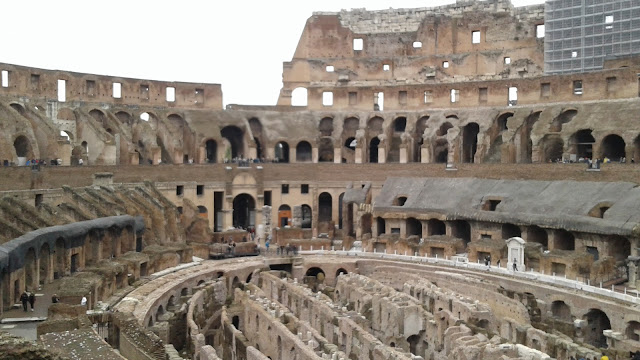 |
| Colosseum |
Rome's gift to the world, the Roman arch. While its true that other cultures knew of and used arches in a limited way, it was the Romans who figured out how to use them to support the weight of massive buildings. The Colosseum and Pantheon are two significant examples. The fact that these structures still stand nearly 2000 years later is a testament to their genius.
In addition to the use of arches in buildings, the Romans also used arches to commemorate victorious generals and their triumphs. Occasionally the arch was used to acknowledge an achievement such as the completion of a road or bridge. In that regard, the arch was central to the expansion of the Roman empire which would not have been possible without bridges built with arches.
 |
| Arch of Constantine |
Initially, I was not exceptionally enthused about visiting the Colosseum considering its history. Although it is history, I find the whole idea of gladiators repulsive. But I was so glad that I overcame that and visited. The structure itself is absolutely amazing. At one time the entire outside structure was covered in marble. But the inside is an even greater display of their creativity. Under the Colosseum floor was an outstanding system for putting on a show. And that is what is was - a show. There were were compartments for holding the animals, props and gladiators. And there were elevators to bring them up to the Colosseum floor.
 | |
| Compartments under the Colosseum floor | |
To the right are the small compartments under the Colosseum floor and below is the elevator with a trap door. The Colosseum was used for around 400 years and during that time it is estimated that approximately 400,000 people died here. Apparently, the "shows" were all day affairs composed of several "acts" and an "intermission". Similar to today there were vendors that sold food and other items to the audience.
 |
| Elevator |
Throughout the structure it is easy to see the extensive use of arches. Arches and columns. Once the Colosseum was no longer used Romans began to see the Colosseum as a "quarry". Much of the structure was carted off for personal use. It wasn't until the 19th century that preservation efforts really took hold at the behest of Pope Pius VIII.
 |
| Colosseum |
Another fine example of the use of arches in construction is the Pantheon. The Pantheon holds the distinction of being the best preserved monument from ancient Rome. Originally a temple for the Roman Gods the Pantheon is now a Catholic church. Amazingly, nearly 2000 years after the Pantheon was built it still has the worlds largest concrete dome that is not reinforced.
 |
| Pantheon |
 | |
| Inside the Pantheon - arches and columns | |
Services are still held at the Pantheon but is also serves as the burial place of of some important folks. Notably the painter Raphael is buried in the Pantheon along with some Kings and a Queen. The interior marble of the building has largely survived but the exterior marble did not.
With the marble facade missing on the exterior of the Pantheon it is easy to see the arches. It seems such a simple thing but that simple "architectural" element essentially allowed the creation of the Roman Empire and led the way for modern architecture. Perfection of arches allowed Romans to build aqueducts that supplied water to Roman citizens, bridges that connected regions allowing expansion of the empire and the massive expansion of building projects. Romans owed much to that simple arch but so do we as it was foundational.

No comments:
Post a Comment